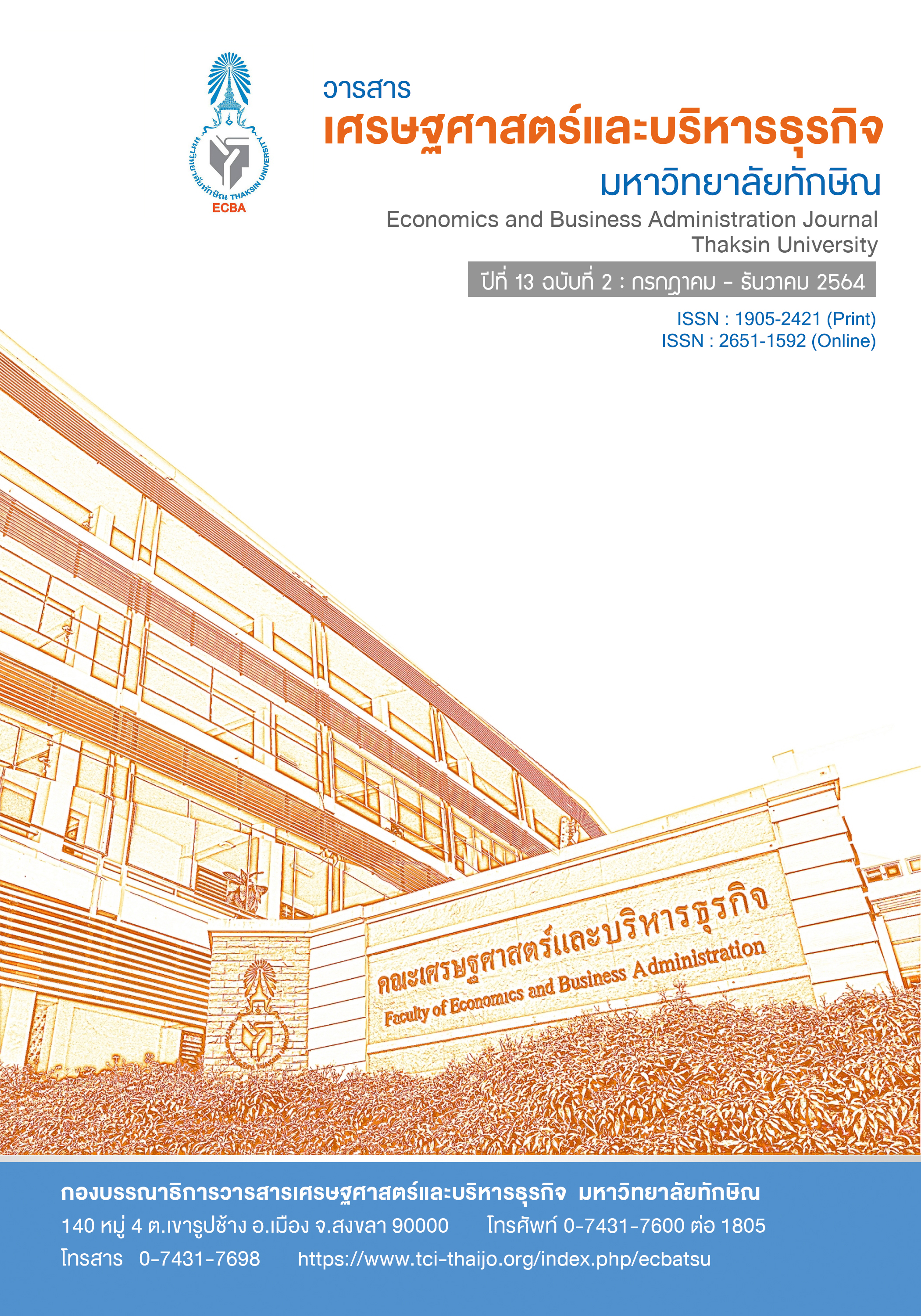ความสัมพันธ์เชิงสาเหตุของปัจจัยแวดล้อมระดับมหภาค ทักษะทางการเงิน และการจัดการการเงินส่วนบุคคล ที่เป็นสาเหตุปัจจัยแห่งความสำเร็จในการออมเงินของ Gen Y เพื่อวัยเกษียณ
คำสำคัญ:
ความสัมพันธ์เชิงสาเหตุ, ปัจจัยแห่งความสำเร็จในการออมเงินเพื่อวัยเกษียณ, Gen Yบทคัดย่อ
งานวิจัยมีวัตถุประสงค์เพื่อศึกษาความสัมพันธ์เชิงสาเหตุของปัจจัยแวดล้อมระดับมหภาค ทักษะทางการเงิน และการจัดการการเงินส่วนบุคคล ที่เป็นสาเหตุปัจจัยแห่งความสำเร็จในการออมเงินของ Gen Y เพื่อวัยเกษียณ โดยวัดความสำเร็จที่ จำนวนเงินออม ความสม่ำเสมอในการออม จำนวนปีที่ออมผ่านมาและจำนวนผลตอบแทนต่อปี เป็นงานวิจัยแบบผสมผสาน (Mixed-Methods) จากกลุ่มตัวอย่าง (ผู้ที่เกิดปี 2523 – 2543) และเป็นผู้ที่มีสัญชาติไทยจำนวน 400 ราย โดยใช้วิธีวิเคราะห์ทางสถิติ ได้แก่ เครื่องมือทางเทคนิคสถิติ Structural Equation Modeling (SEM) ผลการศึกษาสรุปได้ดังนี้ (1) เพื่อศึกษาปัจจัยแห่งความสำเร็จในการออมเงินได้แก่ การจัดการการเงินส่วนบุคคล คือ ด้านรายได้ ด้านรายจ่าย ด้านเงินออม และด้านการลงทุน (2) เพื่อวิเคราะห์ความสอดคล้องของรูปแบบเชิงสมมติฐานของความสัมพันธ์เชิงสาเหตุระหว่างปัจจัยแห่งความสำเร็จในการออมเงินของ Gen Y เพื่อวัยเกษียณกับข้อมูลเชิงประจักษ์ โมเดลมีความสอดคล้องกัน โดยทักษะทางการเงินได้แก่ ความรู้ทางการเงิน พฤติกรรมทางการเงิน และทัศนคติทางการเงิน มีค่าอิทธิพลทางตรงเท่ากับ 0.38 อย่างมีนัยสำคัญทางสถิติที่ระดับ 0.01 ต่างก็เป็นปัจจัยที่มีอิทธิพลต่อความสำเร็จในการออมเงินของ Gen Y เพื่อวัยเกษียณทั้งสิ้น
References
Bank of Thailand. (2012). How to do when getting too old before being rich. Retrieved from https://www.bot.or.th/Thai/ResearchAndPublications/articles/Pages/Article_22Feb2021.aspx.
Bunchay, C. (2009). Personal financial management: case study of working people in Bangkok area. Bangkok: Dhurakij Pundit University.
Cavusgil, S. T., Zou, S. & Naidu, G. M. (1993). Product and promotion adaptation in export ventures: An empirical investigation. Journal of International Business Studies, 24(3), 479-506. Franco M. (2003). The American Economist. 47 (1), 3-24.
Department of International Economic Affairs. (2012). Organization for Economic Co-operation and Development. Retrieved December 25, 2019 from https://business.mfa.go.th/th/content/16519.
Department of provincial Administration. (2016). Thai citizen amount. Retrieved from https://stat.bora.dopa.go.th/new_stat/webPage/statByAgeMonth.php.
Jame, S. D. (1959). Underlying Factors in the Post-War Inflation. Myers
Judith, S. R. & Burke J. (2017). How to Construct a Mixed Methods Research Design.
Karunapen, S. (2017). Factors Affecting Saving level and Saving Behavior of Gen Y: Thammasat University.
Kempson, S. C. & Nick, M. (2005). Financial Services Authority. Financial Services Authority Publication date: June 2005.
Kohli, A. K., Jaworski, B. J. & Kumar, A. (1993). MARKOR: A measure of market orientation. Journal of Market Research, 30(4), 467-477.
Lamsam, A., Boonlert, R., Choedpasuporn, S. & Chantarat, S. (2019). Understanding Saving Behavior through 80 Million Deposit Accounts in Thailand. PIER Discussion Paper Forthcoming.
Margo, T., Jason, C. & Hannah, D. (2019). Thailand Has a Developing Economy and a Big First World Problem.
Milton, F. (1957). The Permanent Income Hypothesis. Chapter Author: Milton Friedman.
Philip, S. (2015). Multistage sampling, BMJ (online) 351:h4155, DOI: 10.1136/bmj.h4155.
Porter, M. E. (1994). Global Strategy: Winning in the World-Wide Marketplace. The Portable MBA in Strategy, edited by Liam Fahey and Robert M. Randall. New York: John Wiley & Sons, 1994.
Routledge and Kegan Paul. (1952). “The Problem of Generations,” in Essays on the Sociology of Knowledge (London,): pp. 276–32.
Wong, M., Gardiner, E., Lang, W. & Coulon, L. (2008). Generational differences in personality and motivation: Do they exist and what are the implications for the workplace? Journal of Managerial Psychology, 23(8), 878-890.



